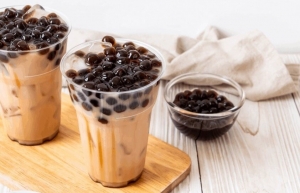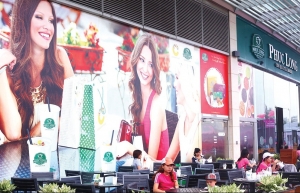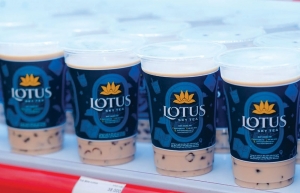Bubble tea luring in new age groups with fresh products
In August, a report published by the Singapore-based market research company Momentum Works and qlub, stated that bubble tea has caused a craze across Southeast Asia over the last several years. Notably, Vietnam is only surpassed by Indonesia and Thailand in boba tea consumption, with over $362 million spent annually.
 |
| Bubble tea luring in new age groups with fresh products, Photo: Shutterstock |
Boba tea continues to be popular among Vietnamese consumers owing to high market demand and frequent reinvention.
Several big players with an average price ranging from $3-4 per cup include Koi Thé, The Alley, Phuc Long, Gongcha, and Tocotoco. Other names pricing between $1.10 and $1.70 per cup are Ngo Gia, Maycha, and Tiger Sugar, among thousands of other small ventures.
According to Statista, by April this year Vietnam boasted nearly 450 milk tea businesses, with more than half situated in Ho Chi Minh City. Local bubble tea chain Bobapop has the most locations with 89, followed by the international brands of Tiger Sugar, The Alley, and Gong Cha with 48, 47, and 42 stores, respectively.
The boba tea market also saw significant investments that indicate a great deal of future bloom. For instance, Masan, which owns the Phuc Long brand, recorded in its H1/2022 financial statement that the brand’s revenues reached $35.1 million in the first half of this year, an increase of 38.5 per cent compared to the same period in 2021.
In August, the firm spent an additional $135 million through a subsidiary to acquire 11 million shares of Phuc Long, corresponding to a 34 per cent ownership stake. This transaction has lifted Masan’s shareholding to 85 per cent and Phuc Long’s estimated value to $455 million.
In terms of attributes, bubble tea is a clever blend between a beverage and a dessert that can fulfil the sweet tooth of customers. In the past, the drink was solely recognised for the combination of dried tea leaves such as oolong and green tea, milk, and toppings, with black boba being the most common. Currently, its flavour and recipe are continuously altered to adjust to the changing customer behaviour.
An Viet Dung, a 25-year-old office worker with a penchant for milk tea, told VIR, “My personal taste is Alisan milk tea because of it is moderate flavour. Nevertheless, the aroma of tea, combined with the salty floating cream and black boba or pudding toppings, makes for a very realistic, unique, and irresistible combination.”
Apart from the increasing variations in flavour, the target audience of bubble tea is expanding to include the middle-aged and elderly, who often lack interest in sweet beverages.
Tran Quoc Khanh, store manager of Gong Cha, told VIR, “Only around 10 per cent of our customers are students and youngsters while up to 70 per cent are office workers. This sector prefers to place orders via food delivery apps and often reserves a dozen cups.” Gong Cha debuted in Vietnam in 2014 and has sold Taiwanese-style boba drinks ever since.
“At Gong Cha, up to 20 per cent of customers are elderly, such as grandparents who bring their grandkids to the shop to buy a drink. Unlike young customers, they do not order new drinks. Instead, they have traditional tea drinks that are milk-free or less milk, and always pick boba for the toppings,” Khanh added. “We used to welcome a group of four or five elderly coming for bubble tea and chat like they would at a coffee shop.”
Price may be the reason why the brand does not appeal to many young boba fans. Gong Cha’s average price per cup is around $3, which is more than the median price at comparable bubble tea houses. In Hanoi, there are several milk tea franchises that charge around $1-1.50 per cup, which is more affordable for the young segment, including current popular brands such as Do Do, which charge $1 for all varieties.
South Korean shift supervisor Junho Kim said, “I consume at least three cups of milk tea per week, and occasionally five or six. I often stop at the milk tea cafe to do job tasks and fulfil deadlines. Because of the diversity of beverages, I find it better to work at a milk tea shop than a coffee shop.“
Le Tuan, who is 60 years old, added, “I am not a big fan of milk tea, but I prefer the chewy texture of boba. At this age, I need to moderate my sugar consumption because of health concerns. My favourite order is a medium-sized cup with less sugar and extra boba.”
Tran Ngoc An, representative of Gong Cha Vietnam said, “Bubble tea is not a fad but has become a popular drink in Vietnam, particularly among generations Y and Z.”
The bubble tea craze appears to be spreading worldwide, not just in Vietnam. The global bubble milk tea market is predicted to reach $4.34 billion by 2028, more than doubling from its value of $1.94 billion in 2020. From 2021 to 2028, the compound annual growth rate is expected to reach 7.8 per cent, as reported by Verified Market Research.
 | Vietnam remains huge potential market for bubble tea Vietnam is a huge potential market for the bubble tea business. This drink is gradually becoming a favourite and popular drink among generations Y and Z. |
 | Bubble tea players wrapping up expansions to conquer the vietnamese market Many bubble tea makers are expanding their operations to conquer the domestic market, which is estimated an equity valuation of nearly $400 million. |
 | Vietnam Airlines offers beloved Milk tea A new milk tea drink produced by Vietnam Airlines is not only taking the skies by storm but is also available on the ground. |
What the stars mean:
★ Poor ★ ★ Promising ★★★ Good ★★★★ Very good ★★★★★ Exceptional
Related Contents
Latest News
More News
- Vibrant Vietnamese cuisine fit for global tastes (June 09, 2025 | 10:42)
- Vietnam can be global hot spot in 2025 (January 29, 2025 | 00:38)
- Promoting tourism and hospitality with sustainability (January 28, 2025 | 09:00)
- Vietnam centres on eco-luxury tourism and hospitality (January 28, 2025 | 02:06)
- Growth prospects for Vietnam’s event tourism in 2025 (January 28, 2025 | 01:18)
- Core values drive success at Marriott (January 24, 2025 | 16:00)
- Hoteliers to prioritise eco-luxury (January 04, 2025 | 09:00)
- Vietnam upscale tourism on the rise for 2025 (December 30, 2024 | 12:03)
- Addressing concerns can shape green hospitality (December 04, 2024 | 10:24)
- Vietnam’s sports economy to lead a new era of development (November 06, 2024 | 16:31)

 Tag:
Tag:





















 Mobile Version
Mobile Version